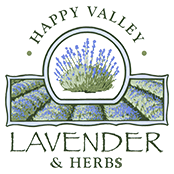|

March 2004
The Sleeping Promise
Success propagating Sweet Lavender from seeds
Tip a package of seeds into your hand…any seeds. Like grains of sand on the beach or stars in the sky, each one seed regardless of its shape, size or colour represents a "planet" (or plant-to-be) in the universe of your garden, all other plants swirling around it. I never cease to be amazed at the diversity of seeds with no seeming rhyme, reason or code to tell me truly whether it will be a dwarf alpine plant, a water lily or a majestic tree.
Lavender seeds look like fleas! Legless ones granted and yet they propel us to primp and pamper them for their promised future baby Lavender-ness and tote them around our garden for the perfect spot to complete their success!
Lavender seeds need patience. They are recalcitrant to leave their cozy space capsule until the timing is to their choosing…Here are a few ways to prod them awake or to orchestrate that timing.
Firstly, check your seeds are no more than three years old before you start. Secondly, make sure you have stored all your seeds in a cool, dark, dry container to keep then fully viable. Cookie tins work well stored in a spare bedroom, closet or even a garage in the shade. If in doubt, please buy fresh seeds.
Now for Lavender's personal requests… Use a "light" soil mix, like a general sterilized non-soil potting mix used for hanging baskets or flower boxes. Blend two parts of your mix to one part sand or medium perlite to amend the drainage properties.
Use a shallow seeding box or a seeding tray with "plug" compartments. (An all-purpose size is commonly referred to as a six pack.) This helps keep the soil temperature warmer when wet compared to a deep soggy pot. Press the seeds lightly on the surface of the seeding tray or try to place one or two seeds per compartment or plug. Cover the seeds by sprinkling a thin layer of fine sand as a top dressing. This also helps prevent seed rot and fungus gnats (tiny BUGS) from setting up home on the surface of warm damp soil. Water lightly.
If you are starting your seeds in February or March~ you can simply place them in their trays outside on a bench to experience normal frosts/warming trends. They will germinate late April, early May as the season progressively warms up. By late May I have very sturdy starts that need no hardening off, totally comfortable in the real world. No fuss (or attention) on my part after seeding.
If you are starting your seeds April, May or June~ I freeze the seeds in a Ziploc bag BEFORE sowing to give them an artificial winter. The "quick frost" then warming, helps crack the protective coating that seals the germ of the seed inside. Cold frames help speed up the warming trend after their deep chill or place on a heating cable in a cool greenhouse. It is more important to have bottom heat than top here to get the Lavender to "pop" out of dormancy and become a seedling. Three weeks is not unusual to wait for any sign of life, if say, you start them inside April the first or so.
Once the first two immature leaves appear, light becomes a factor to start up the chlorophyll cycle and "green" up your babies. Growing lights can be added at this time if you are tucking your propagation table in a dimmer basement or shed. A cold frame outside or greenhouse usually has enough natural light~ you do not need to fuss.
Do not disturb, thin or transplant until the second set of true leaves have developed. I tend to wait until they are a good inch high and have waited longer until the center stem darkens to a brown colour and the baby Lavender has three or four sets of leaves. The plug trays facilitate pushing the little package of soil and seedling out to place into a prepared individual two or four inch pot. Use a slightly richer soil blend with compost or slow release fertilizer: again, mix two parts to one part drainage material. Set the plug at the same soil level in the pot that it sat in the plug tray. Firm into place. Water lightly.
If you need to separate a clump of seedlings from your open seeding tray, loosen the soil gently under the group with an old spoon or knife. Pick up the soil clump and gently loosen the soil; teasing the seedlings apart by touching their tops, not the fragile new rootlets. The idea being, bruising is done to a replaceable leaf and not the feeder roots. Do NOT hold by their "necks" (tender central stem)~ they die. Dangle the root area into a prepared depression in the new pot, firming the surrounding soil to set the seedling upright. Then trim if it is tall enough. Definitely at about two inches plus, I trim back a good half-inch to stimulate side growth from the central stem.
Do not over water after transplanting, watch your air circulation in an enclosed space and give them your brightest sun/light. Baby Lavenders are very susceptible to moulds, mildews and damping off from being too wet. As their growth progresses and starts to speed up, do fertilize lightly with diluted liquid feed, especially if your soil mix is pure potting soil and sand.
By June I hope to see you, potted plant in hand, murmuring to your pet Lavender," How about here?"…"Or over here?" …Choose a site in full sun with fairly rich soil, good drainage AND most importantly, somewhere you will walk by regularly. Even brushing the growing foliage will give you a sense of the fullness of the Lavenders scent to come when in full bloom. Do not be surprised if your first year Lavenders do not set bloom. Personally I keep trimming the juvenile plants to promote bushy-ness and I actually stop the blooming spikes forming that whole first summer for a bumper crop of blooms the second season. This extra pruning also shapes the Lavender to become a sturdy, short plant with no straggly off set "arms", delays central woody-ness and prepares them for our climates occasional heavier wet snow. I like to think every time I prune a tip~ I am creating two blooms next year!
From the second year on, I do two "haircuts" a year. One trim mid-spring, removing one third of the green growing area before it sets bloom. The next one mid summer, or full bloom time, cutting the full length of the bloom stem plus just into the leaf area. If you are using Lavender for a formal hedge, cut the sides first then square off the top. Never cutting into the woody-ness, but keeping in the green growing area. Still cut your Lavender hedge twice as above.
Do baby your Lavenders the full first year in their garden site to develop a strong root system for subsequent times of normal summer fluctuations of drought and winter's frost and snow. This also includes side dressing with soil amendments. (Lavenders like wood ash if you have a wood stove this winter-save the ash).
Well tended in their early development, a Sweet Lavender (L. angustifolia) easily bears up to ten years and keeps a "good figure"!
Spanish and French Lavenders (L. stoeches or L.dentatas) have two main differences to the traditional Sweet Lavenders. Firstly these semi-tropicals bloom continuously from as early as March to as late as October. Secondly, sadly, a harsh winter shortens their life span and can snap freeze them to death at any age. To quickly replace their spot in your overall design scheme~ cheat! Purchase a four inch (first year) or gallon (second year) plant to pop in place in the next late April/May ...
In the olde Victorian language of Flowers, Lavender stands for "Devotion". Do you think the Devotion bit belongs to the plant: or you, the gardener?!
Good Luck with this seeding season ~
Herbally yours ~ LYNDA
Originally published in the March 2004 edition of the Metchosin Muse
Printable Version 
|

